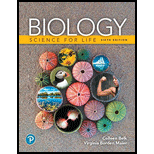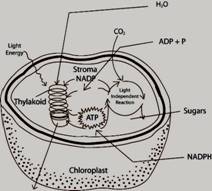
Concept explainers
Add labels to the figure that follows, which illustrates the product and reactants of photosynthesis and the relationship between its light reactions and light-independent reactions.

To label:
The given figure, which illustrates the product and reactants of photosynthesis and the relation between its light reaction and light-independent reactions.
Introduction:
Photosynthesis is a phenomenon that changes solar energy to chemical energy needed by all living organisms. Photosynthesis occurs in chloroplasts that found in the green part mainly in leaves of the plants.
Explanation of Solution
Photosynthesis can be broken down into two steps - light reaction and light-independent reaction.
Light reaction - Light reaction occurs when there is sunlight. Sunlight hits the chlorophyll molecule in the thylakoid membranes that excites electrons. These electrons are captured and passed through an electron transport chain that generates the energy-carrying molecules ATP. The electrons then transfer to the molecule NADPH. The electrons removed from chlorophyll in this way are replaced by those from water, which decompose to release them, a reaction that produces oxygen as a waste product.
Light-independent reaction - The ATP and the electrons in NADPH are utilized in the synthesis of sugar from CO2 in the second major step of photosynthesis called light-independent reactions. It occurs mainly in the stroma of the chloroplast and is sometimes referred to as the Calvin cycle.
The following labeled figure shows the products and reactants and the relation between its light-independent reaction and light reaction.

Fig:
The process of photosynthesis.
Thus, photosynthesis happens in two steps - light reaction and light-independent reaction.
Want to see more full solutions like this?
Chapter 5 Solutions
EBK BIOLOGY:SCIENCE F/LIFE
- A 10 mg/Kg dose of a drug is given by intravenous injection to a 20 Kg dog. What would the volume of distribution be if the drug had been given orally and only 50% of the drug was absorbed (the concentration of drug at time = 0 is 0.1 mg/L)? Be sure to show your work.arrow_forwardAfter oral administration of 10mg of a drug, 50% is absorbed and 40% of the amount absorbed is metabolized by the first pass effect. The bioavailable dose of this drug is ______. Make sure to provide units for your answer. Show your work.arrow_forwardA 10 mg/Kg dose of a drug is given by intravenous injection to a 20 Kg dog. What is the volume of distribution of the drug in liters if the plasma concentration is 0.1 mg/L (assume the drug is instantaneously distributed)? Be sure to show your work.arrow_forward
- Using a BLAST search, what class of proteins is similar to bovine angiogeninarrow_forwardIdentify an article within a Nursing Journal. Discuss how the issue within the article impact how we provide care. Please give in text citations and list references.arrow_forwardI have a question. I need to make 25 mL of this solution . How would I calculate the math? Please helparrow_forward
- Introduction to blood lab reportarrow_forwardWhich of the structural components listed in the Essential terms of section 1.3 (Cell components) could occur in a plant cell? Paragraph く BIUA 川く く 80 + кл Karrow_forwardWhich of the following statements refer(s) directly to the cell theory? (Note that one or more correct answers are possible.) Select 2 correct answer(s) a) There are major differences between plant and animal cells. b) There are major differences between prokaryote and eukaryote cells. c) All cells have a cell wall. d) All cells have a cell membrane. e) Animals are composed of cells. f) When a bacterial cell divides, it produces two daughter cells.arrow_forward
- Preoperative Diagnosis: Torn medial meniscus, left knee Postoperative Diagnosis: Combination horizontal cleavage tear/flap tear, posterior horn, medial meniscus, left knee. Operation: Arthroscopic subtotal medial meniscectomy, left knee Anesthetic: General endotracheal Description of Procedure: The patient was placed on the operating table in the supine position and general endotracheal anesthesia was administered. After an adequate level of anesthesia was achieved, the patient's left lower extremity was prepped with Betadine scrubbing solution, then draped in a sterile manner. Several sites were then infiltrated with 1% Xylocaine solution with Epinephrine to help control bleeding from stab wounds to be made at these sites. These stab wounds were made anterolaterally at the level of the superior pole of the patella for insertion of an irrigation catheter into the suprapatellar pouch area, anterolaterally at the level of the joint line for insertion of the scope and anteromedially at…arrow_forwardUARDIAN SIGNA Life Sciences/ Baseline Test Grade 10 ry must be written in point form. pot in full sentences using NO MORE than 70 words sentences from 1 to 7. only ONE point per sentence. words as far as possible. number of words you have used in brackets at the end GDE/2024 QUESTION 3 The table below shows the results of an investigation in which the effect of temperature and light on the yield of tomatoes in two greenhouses on a farm was investigated. TEMPERATURE (°C) AVERAGE YIELD OF TOMATOES PER 3.1 PLANT (kg) LOW LIGHT LEVELS HIGH LIGHT LEVELS 5 0,5 0,5 10 1,5 2,5 15 3,0 5,0 20 3,6 8,5 25 3,5 7,8 30 2,5 6,2 State TWO steps the investigator may have taken into consideration during the planning stage of the investigation. (2) 3.2 Identify the: a) Independent variables (2) b) Dependent variable (1) 3.3 Plot a line graph showing the results of the average yield of the tomatoes from 5°C to 30°C for low light levels. (6) 3.4 State ONE way in which the scientists could have improved the…arrow_forwardExplain why you chose this mutation. Begin by transcribing and translating BOTH the normal and abnormal DNA sequences. The genetic code below is for your reference. SECOND BASE OF CODON כ FIRST BASE OF CODON O THIRD BASE OF CODON SCAGUCAGUGAGUCAG UUU UUC UCU UAU UGU Phenylalanine (F) Tyrosine (Y) Cysteine (C) UCC UAC UGC Serine (S) UUA UUG Leucine (L) UCA UCG_ UAA UGA Stop codon -Stop codon UAG UGG -Tryptophan (W) CUU CUC CCU CAU CGU Histidine (H) CCC CAC CGC -Leucine (L) Proline (P) CUA CCA CAA CUG CCG CAG-Glutamine (Q) -Arginine (R) CGA CGG AUU ACU AAU AGU AUC Isoleucine (1) Asparagine (N) ACC AAC Threonine (T) AUA ACA AAA Methionine (M) Lysine (K) AUG ACG Start codon AAG AGC-Serine (S) -Arginine (R) AGA AGG GUU GCU GAU GUC GUA GUG GCC Valine (V) -Alanine (A) GCA GCG GAC GAA GAG Aspartic acid (D) GGU Glutamic acid (E) GGC GGA GGG Glycine (G) In order to provide a complete answer to the question stated above, fill in the mRNA bases and amino acid sequences by using the Genetic Code…arrow_forward

 Concepts of BiologyBiologyISBN:9781938168116Author:Samantha Fowler, Rebecca Roush, James WisePublisher:OpenStax College
Concepts of BiologyBiologyISBN:9781938168116Author:Samantha Fowler, Rebecca Roush, James WisePublisher:OpenStax College Biology 2eBiologyISBN:9781947172517Author:Matthew Douglas, Jung Choi, Mary Ann ClarkPublisher:OpenStax
Biology 2eBiologyISBN:9781947172517Author:Matthew Douglas, Jung Choi, Mary Ann ClarkPublisher:OpenStax Biology (MindTap Course List)BiologyISBN:9781337392938Author:Eldra Solomon, Charles Martin, Diana W. Martin, Linda R. BergPublisher:Cengage Learning
Biology (MindTap Course List)BiologyISBN:9781337392938Author:Eldra Solomon, Charles Martin, Diana W. Martin, Linda R. BergPublisher:Cengage Learning Biology: The Dynamic Science (MindTap Course List)BiologyISBN:9781305389892Author:Peter J. Russell, Paul E. Hertz, Beverly McMillanPublisher:Cengage Learning
Biology: The Dynamic Science (MindTap Course List)BiologyISBN:9781305389892Author:Peter J. Russell, Paul E. Hertz, Beverly McMillanPublisher:Cengage Learning Biology Today and Tomorrow without Physiology (Mi...BiologyISBN:9781305117396Author:Cecie Starr, Christine Evers, Lisa StarrPublisher:Cengage Learning
Biology Today and Tomorrow without Physiology (Mi...BiologyISBN:9781305117396Author:Cecie Starr, Christine Evers, Lisa StarrPublisher:Cengage Learning





